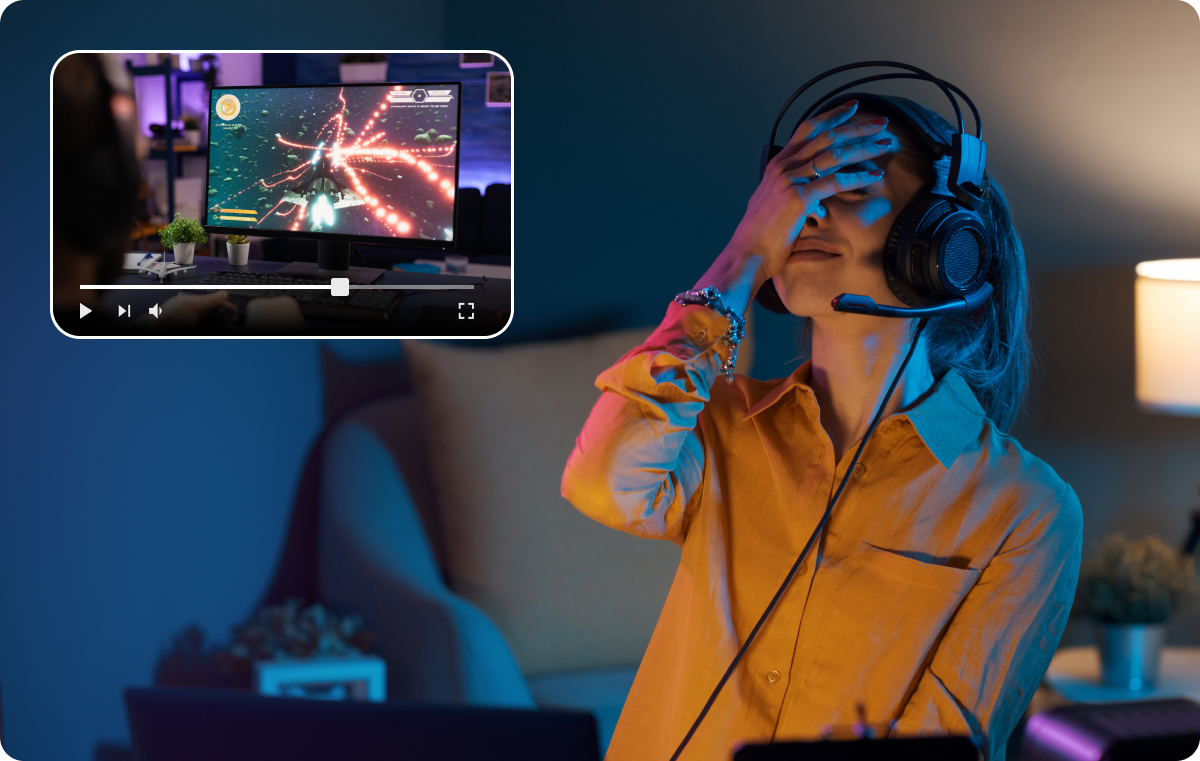Whether you respond to a viral meme, music video, or heartfelt moment, reaction videos let you combine your personality with popular trends. These posts are a great way to quickly make trending content without hours of scripting and editing.
Read on to learn about recording and editing reaction videos to build your social media presence.
What’s a Reaction Video?
In a reaction video, you film yourself responding to a piece of media, like news, music, or viral clips. People like watching these clips because they get to see your genuine expressions, ranging from shock to uncontrollable laughter.
Reaction videos usually have two formats:
- Split screen — Your video appears side by side with the original content so viewers can watch both at the same time.
- Picture-in-picture — Your face is in a small window over the content, making it easy to focus on your response without losing sight of the media you're reacting to.
Why You Should Make Reaction Videos
Reaction videos offer several unique benefits — here are a few reasons to add this content to your lineup.
Audience Engagement
Reaction videos are a great way to connect with your audience on a personal level. Sharing your thoughts and emotions as you watch a piece of content makes viewers feel like they're reacting to something alongside you. This builds a sense of community and can result in more interactions like comments, likes, and shares.
For example, a creator who makes movie-related content might respond to a new trailer. This could spark discussions in the comments, where people share their excitement and opinions about the upcoming film.
Content Diversity
Filming reaction videos lets you mix up your content without straying too far from your niche. You can respond to trending topics, viral clips, or other content types that align with your brand. This strategy keeps your audience entertained while staying true to your voice.
Say a tech reviewer shares their opinion about a recent product launch event. This short "initial thoughts" clip creates a buzz around the in-depth review they'll release a few weeks later and adds variety to their usual posts.
Minimal Production Effort
Compared to other content types, reaction videos are relatively easy to produce. You don't need elaborate setups or scripts — just a camera, the content you're reacting to, and your genuine responses. Without hours of planning, you can create more in less time and stay consistent with your uploads, helping you build your audience.
Social Media Trend Popularity
Commentary videos are especially popular on platforms like YouTube, Instagram, and TikTok. This format is a go-to for many creators, as audiences love watching live reactions to events, music, and memes.
Tapping into this trend lets you ride the wave of a content type that's proven to be successful. As you grow your brand, you draw in existing and new audiences eager to see your take on the latest material.
How To Make a Reaction Video in 4 Steps
Follow these four essential steps to learn how to make reaction videos on YouTube and other popular platforms.
1. Find Something To React To
The first step is choosing the right content to review — content that suits your niche and brand. Look for trending videos, music, or viral moments that match your audience's interests. For example, if you make cooking videos, react to viral recipe trends like cucumber salads or pasta chips.
2. Get the Right Equipment
No matter what kind of content you’re recording, you need a decent setup to produce a quality video. Invest in a good camera, microphone, and light to create a professional look. Try adding a ring light so your facial expressions are well-lit, and use headphones to reduce distracting background noise. If you're on a budget, your phone camera will work fine as long as the audio and video are crisp.
3. Embrace Your Reaction Style
Before you start recording, think about your style. Are you trying to be funny, share thoughtful comments, or give audiences a purely emotional response?
For example, you can pause a music reaction video to share your thoughts or keep your responses spontaneous by letting it play in real time. Try mixing in some commentary, like explaining why a video has gone viral or sharing a related personal story.

4. Record Your Reaction
Once you're ready to film, set up a split screen or picture-in-picture overlay to record your reaction alongside the content. Make sure your body language and facial expressions are visible, and sync your responses with the video. Pause at key moments to share your thoughts, make predictions, or ask your audience questions.
How To Edit Reaction Videos: 6 Tips
After recording, the next step is editing it to create a polished, ready-to-publish video. While you can use YouTube’s built-in editing tools, Captions' AI features help you create professional-quality videos faster — here's how.
1. Upload and Sync the Videos
Import your video and the content you're reacting to into Captions. Sync the footage so your expressions and audio match up, making your commentary seem natural and well-timed.
If you want your response to stand out, use a picture-in-picture format to show your face in a small window over the content. For a more balanced view, go for a split screen that shows the content and your reaction side by side.

2. Remove Background Noise and Distractions
Next, clean up your post by cutting out unwanted audio. Captions’ AI Denoise feature automatically removes background noise, making your speech sound crisp and professional. You can also use AI Trim to remove filler words, pauses, and mistakes.
3. Add Captions
To make your reaction video accessible to a broader audience, add subtitles. Captions help viewers who are deaf or hard of hearing understand your content, and they allow people to follow along in noisy environments. You can personalize subtitles in Captions by choosing different fonts, colors, and styles to fit your brand.
4. Fix Eye Contact
Maintaining eye contact with the camera helps create a stronger connection with your audience. This is especially true during reaction videos, where you constantly look between your camera and the content you're reacting to. If your eye contact is a bit off, Captions can correct it in post-production, saving you the trouble of rerecording.
5. Add Music
Using music in YouTube videos sets the tone for your reactions. With Captions, you can choose royalty-free tracks based on genre, mood, or theme, and AI will automatically arrange the music to fit your video. The software even lowers the volume when it detects speech so your viewers never miss a word.
6. Repurpose Your Reaction Video
After editing your reaction for YouTube, use it to make short-form content for other social media platforms. Captions' AI Shorts feature finds the best segments from your longer video and converts them into shorter clips. You can post these on YouTube Shorts, Instagram Reels, or TikTok to promote and monetize your brand across multiple channels.
Take Your Reaction Videos to the Next Level With Captions
High-quality reaction videos are a simple way to connect with your audience, show your personality, and keep your content fresh.
With Captions, you can bring your creative reaction video ideas to life while growing your following. No matter your niche, Captions' AI features save you time, make your content more accessible, and let you reuse your content on multiple platforms.









